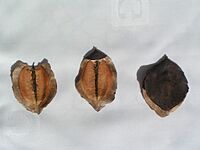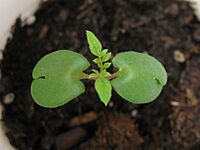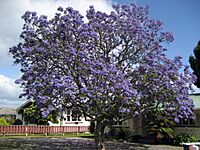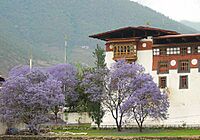Blue jacaranda facts for kids
Quick facts for kids Blue jacaranda |
|
|---|---|
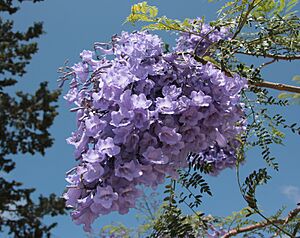 |
|
| Conservation status | |
| Scientific classification | |
| Genus: |
Jacaranda
|
| Species: |
mimosifolia
|
| Synonyms | |
|
|
The jacaranda tree (scientific name: Jacaranda mimosifolia) is a beautiful tree from South America. It is famous for its amazing, long-lasting violet-colored flowers. People often call it the blue jacaranda or fern tree because of its fern-like leaves. While "jacaranda" is the name for a whole group of trees, most people use it to mean this specific blue-flowered one. In the wild, the blue jacaranda is considered a vulnerable species, meaning it needs protection.
Contents
What Does a Jacaranda Tree Look Like?
Jacaranda trees can grow quite tall, up to 20 meters (about 65 feet). Their bark is thin and grey-brown. When the tree is young, the bark is smooth, but it becomes a bit scaly as it gets older. The branches are thin and have a reddish-brown color.
Flowers and Seeds
The flowers are about 5 centimeters (2 inches) long. They grow in large bunches called panicles, which can be up to 30 centimeters (12 inches) long. These beautiful flowers appear in spring and early summer and can last for up to two months.
After the flowers, the tree grows woody seed pods. These pods are round, about 5 centimeters (2 inches) across. Inside, they hold many flat, winged seeds. These unique pods are sometimes collected and used for decorations, like on Christmas trees!
Leaves
Even when it's not blooming, the blue jacaranda is loved for its large, fern-like leaves. These leaves can be up to 45 centimeters (18 inches) long. Each leaf is made up of many tiny leaflets, which are only about 1 centimeter (less than half an inch) long. There are even some jacaranda trees that have white flowers instead of purple ones!
Jacaranda Wood
The wood of the jacaranda tree is light grey or whitish. It is usually straight and does not have many knots. This wood is quite soft and easy to work with. People often use it for turning on a lathe, like making bowls, even when the wood is still fresh or wet.
Where Do Jacaranda Trees Grow?
The blue jacaranda originally comes from South America. You can find it in southern Brazil, Paraguay, Bolivia, and parts of Argentina. It grows in dry areas and also in savannas that sometimes flood. It can even be found in the Andes mountains, up to 2600 meters (about 8,500 feet) high.
Sadly, in its natural home, the jacaranda tree is considered vulnerable. This is because too many trees are being cut down for wood or to clear land for farming.
Jacaranda as an Invasive Species
While loved in many places, the jacaranda is seen as an invasive species in some parts of South Africa and Australia. This means it can grow so well there that it takes over and harms the plants that naturally belong in those areas.
Growing Jacaranda Trees Around the World
The blue jacaranda is grown in many places around the world where it doesn't get too cold. Mature trees can handle short periods of cold temperatures, even down to about -7°C (19°F). Even if young trees get damaged by frost, they often grow back from their roots. However, they might grow more like a bush and not flower as much.
This beautiful plant has won an award called the Royal Horticultural Society's Award of Garden Merit. This award shows it is a great plant for gardens.
Famous Jacaranda Cities
- Pretoria, South Africa: This city is often called "Jacaranda City." In spring (October), the city turns blue and purple when thousands of jacaranda trees bloom. For a while, planting new jacarandas was not allowed due to water issues and concerns about invasive species. However, rules have changed, and they can now be planted in some urban areas again.
- Sydney, Australia: The first jacaranda bloomed here around 1850. There's a very old jacaranda tree in the Botanic Garden that is over 175 years old!
- Brisbane, Australia: Jacarandas were brought here in 1864. You can even find guided tours to see the best places to view the flowers.
- Grafton, Australia: This city holds a special jacaranda festival every year in late October and early November to celebrate the blooming trees.
- United States: Jacarandas are very popular in California, the Southwest, Texas, and Florida. They were brought to California by a plant expert named Kate Sessions. You can see them in cities like Phoenix, Arizona, and San Diego, California. They also grow in Hawaii.
- Mexico City, Mexico: Many jacaranda trees bloom here in March, making the city very colorful.
- Buenos Aires, Argentina: This is one of the most common trees in Argentina's capital city.
- Europe: You can find jacarandas along the Mediterranean coast in Spain, Portugal, Italy, Greece, Malta, and Cyprus. They often bloom earlier here than in other parts of Europe.
- Other Countries: Jacarandas are also common in cities across Southern Africa, like Johannesburg, Lusaka (Zambia), Gaborone (Botswana), Nairobi (Kenya), and Harare (Zimbabwe). They are also cultivated in Kathmandu (Nepal) and several states in India. You can also see them in Israel, especially in towns and cities along the coast.
See also
 In Spanish: Jacaranda mimosifolia para niños
In Spanish: Jacaranda mimosifolia para niños



